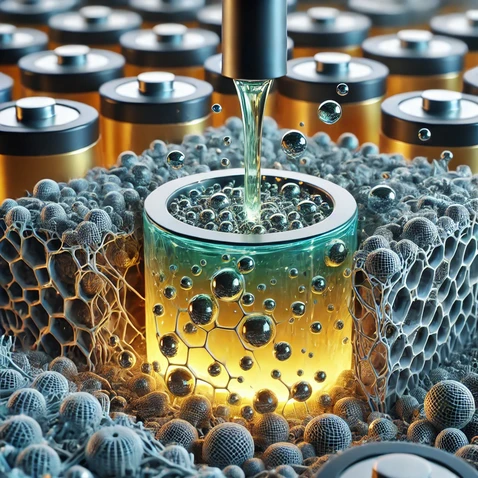Modelling electrolyte transport in porous electrodes
Wissenschaft, ANTARES |

Non-flammable and environmentally friendlier
Among promising candidates as an electrolyte in lithium-oxygen batteries are aqueous solutions with a high lithium salt content. These so-called water-in-salt (WiS) electrolytes possess useful properties for improved performance in lithium-oxygen batteries. Additionally, they are non-flammable and more environmentally friendly compared to batteries based on organic solvents.
Mesoporous carbon is a promising material of choice for the cathode in lithium-oxygen batteries. Besides electrical conductivity, it has to satisfy many other requirements such as high porosity and specific surface area, while maintaining high permeability for oxygen and Li⁺-ions.
Neutrons for a detailed insight
Understanding the interplay of the electrolyte and the cathode material is crucial for the design of an efficient electrode. Together with German colleagues, a group of Argentinian researchers took advantage of the isotope-specific interaction of neutrons with Li-ions. Applying neutron imaging at the ANTARES instrument, they tracked and modelled the transport processes of WiS electrolytes in the monolithic mesoporous carbon.
“We could see that thanks to the sufficiently strong capillary forces, the uptake of viscous solutions of lithium salts by mesoporous carbon is faster than that of pure water. Also, the interdiffusion of Li⁺-ions between the soaked carbon material and the liquid electrolyte phase is surprisingly relatively high”, says Dr. Michael Schulz, a co-author of this study and deputy scientific director at FRM II. The findings may lead to further development of electrodes for lithium-oxygen batteries and supercapacitors.
Publication:
F. M. Cabello, G. Horwitz, A. Tartaglione, M. Schulz, J. H. Marin, A. Rozenblit, M. A. Trejo Urdaneta, M. S. Bellora, F. A. Viva, H. R. Corti, Wettability, imbibition and interdiffusion of lithium-based water-in-salt electrolytes in nano-porous carbon in relation to energy storage: A neutron radiography study, Carbon 228, 119292 (2024)
DOI: 10.1016/j.carbon.2024.119292
Further Information:
The experiments were carried out at STORNI, Bariloche Atomic Centre (CNEA) Argentina, and the instrument ANTARES at MLZ.